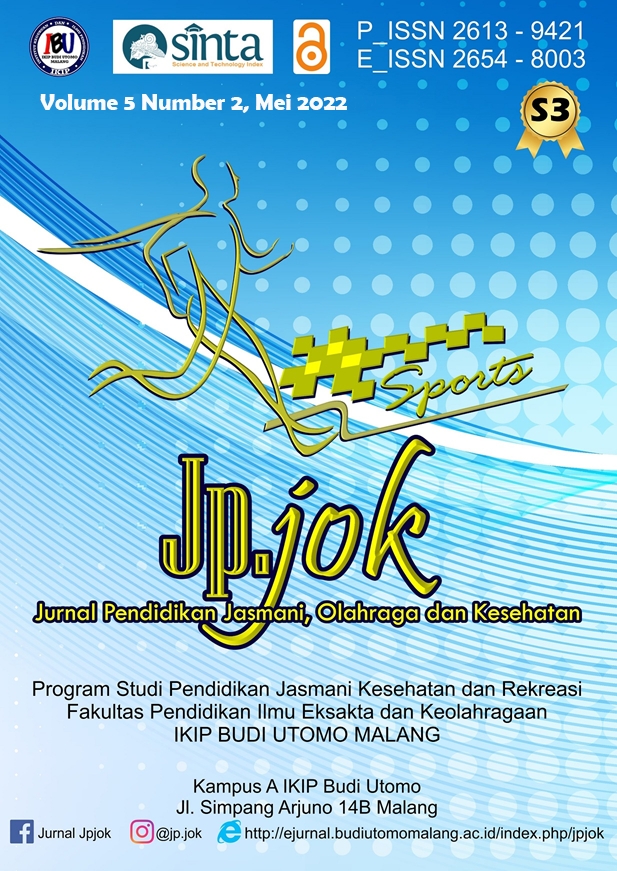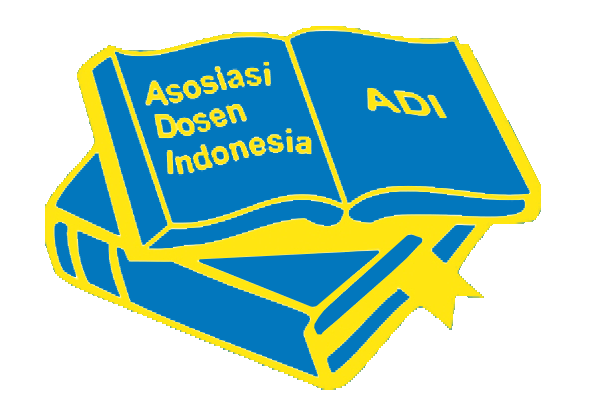Analysis of Physical Education, Sports and Health teacher Strategies in Learning FMS During the Covid Pandemic 19
Abstract
The purpose of this study is to find an overview of how the learning strategies and barriers for Physical Education, Sports and Health teachers providing fundamental movement material during the Covid 19 pandemic. This research includes quantitative descriptive analysis. This research used survey method with close-ended question as the instrument distributed on google form. Respondents in this study were primary school PJOK teachers, in which about 49 people. Data were analyzed using percentage calculations. The conclusions of this study indicate that fundamental movement learning is carried out online by utilizing various kinds of teaching materials such as books, PowerPoint slides, videos, and handouts. The most widely used media is the WhatsApp group. The learning method used by PJOK teachers is the assignment method. The learning strategies carried out generally give students the task of imitating movements, repeating movements, and recording activities. In general, PJOK teachers do not experience obstacles in conducting online learning.
References
Bahcivan, E., Gurer, M. D., Yavuzalp, N., & Akayoglu, S. (2019). Investigating the Relations Among Pre-Service Teachers’ Teaching/Learning Beliefs and Educational Technology Integration Competencies: a Structural Equation Modeling Study. Journal of Science Education and Technology, 28(5), 579–588.
https://doi.org/10.1007/s10956-019-09788-6
Bandura, A. (2004). Health promotion by social cognitive means. Health Education and Behavior, 31(2), 143–164. https://doi.org/10.1177/1090198104263660
Barnett, L., Hinkley, T., Okely, A. D., & Salmon, J. (2013). Child, family and environmental correlates of children’s motor skill proficiency. Journal of Science and Medicine in Sport, 16(4), 332–336. https://doi.org/10.1016/j.jsams.2012.08.011
Barnett, L. M., Stodden, D., Cohen, K. E., Smith, J. J., Lubans, D. R., Lenoir, M., Iivonen, S., Miller, A. D., Laukkanen, A., Dudley, D., Lander, N. J., Brown, H., & Morgan, P. J. (2016). Fundamental movement skills: An important focus. Journal of Teaching in Physical Education, 35(3), 219–225. https://doi.org/10.1123/jtpe.2014-0209
Burstiando, R. (2014). KETERAMPILAN GERAK DASAR SISWA KELAS ATAS MI MIFTAHUL ULUM 3 PERENG KULON GRESIK Bayu. Pendidikan Olahraga, May 2014, 1–17.
Engel, A. C., Broderick, C. R., van Doorn, N., Hardy, L. L., & Parmenter, B. J. (2018). Exploring the Relationship Between Fundamental Motor Skill Interventions and Physical Activity Levels in Children: A Systematic Review and Meta-analysis. Sports Medicine, 48(8), 1845–1857. https://doi.org/10.1007/s40279-018-0923-3
Erfan A.F, Perdinanto, K. M. (2020). SURVEI DENGAN KECAKAPAN GERAK DASAR SEKOLAH DASAR NEGERI BERLAHAN BASAH DI KECAMATAN BABIRIK KABUPATEN HULU SUNGAI UTARA. Jurnal Pendidikan Jasmani Dan Olahraga, 1(1), 68–73.
Ericsson, I. (2011). Effects of increased physical activity on motor skills and marks in physical education: An intervention study in school years 1 through 9 in Sweden. Physical Education and Sport Pedagogy, 16(3), 313–329. https://doi.org/10.1080/17408989.2010.545052
Filiz, B., & Konukman, F. (2020). Teaching Strategies for Physical Education during the COVID-19 Pandemic: Editor: Ferman Konukman. Journal of Physical Education, Recreation and Dance, 91(9), 48–50. https://doi.org/10.1080/07303084.2020.1816099
Jeong, H. C., & So, W. Y. (2020). Difficulties of online physical education classes in middle and high school and an efficient operation plan to address them. International Journal of Environmental Research and Public Health, 17(19), 1–13. https://doi.org/10.3390/ijerph17197279
Kim, J. (2020). Learning and Teaching Online During Covid-19: Experiences of Student Teachers in an Early Childhood Education Practicum. In International Journal of Early Childhood (Vol. 52, Issue 2, pp. 145–158). https://doi.org/10.1007/s13158-020-00272-6
Larsson, H., & Nyberg, G. (2017). ‘It doesn’t matter how they move really, as long as they move.’ Physical education teachers on developing their students’ movement capabilities. Physical Education and Sport Pedagogy, 22(2), 137–149. https://doi.org/10.1080/17408989.2016.1157573
Lewis, S., Whiteside, A. L., & Dikkers, A. G. (2015). Providing chances for students to recover credit: Is online learning a solution? Advances in Research on Teaching, 25(January 2016), 143–157. https://doi.org/10.1108/S1479-368720150000027007
Lopes, V. P., Maia, J. A. R., Rodrigues, L. P., & Malina, R. (2012). Motor coordination, physical activity and fitness as predictors of longitudinal change in adiposity during childhood. European Journal of Sport Science, 12(4), 384–391. https://doi.org/10.1080/17461391.2011.566368
Lubans, D. R., Morgan, P. J., Cliff, D. P., Barnett, L. M., & Okely, A. D. (2010). Fundamental movement skills in children and adolescents: Review of associated health benefits. Sports Medicine, 40(12), 1019–1035. https://doi.org/10.2165/11536850-000000000-00000
Mukherjee, S., Ting Jamie, L. C., & Fong, L. H. (2017). Fundamental Motor Skill Proficiency of 6- to 9-Year-Old Singaporean Children. Perceptual and Motor Skills, 124(3), 584–600. https://doi.org/10.1177/0031512517703005
Nurgiyantoro, B. (2012). Penilaian pembelajaran bahasa. BPFE.
Olrich, T. W. (2002). Assessing Fundamental Motor Skills in the Elementary School Setting: Issues and Solutions. Journal of Physical Education, Recreation & Dance, 73(7), 26–28. https://doi.org/10.1080/07303084.2002.10607843
Putri, R. S., Purwanto, A., Pramono, R., Asbari, M., Wijayanti, L. M., & Hyun, C. C. (2020). Impact of the COVID-19 pandemic on online home learning: An explorative study of primary schools in Indonesia. International Journal of Advanced Science and Technology, 29(5), 4809–4818.
R.Carter. (2002). The impact of public schools on childhood obesity. JAMA, 288(17), 2180.
Russ, L. B., Webster, C. A., Beets, M. W., & Phillips, D. S. (2015). Systematic Review and Meta-Analysis of Multi-Component Interventions Through Schools to Increase Physical Activity. Journal of Physical Activity and Health, 12(10), 1436–1446. https://doi.org/10.1123/jpah.2014-0244
Sepulveda-Escobar, P., & Morrison, A. (2020). Online teaching placement during the COVID-19 pandemic in Chile: challenges and opportunities. European Journal of Teacher Education, 43(4), 587–607. https://doi.org/10.1080/02619768.2020.1820981
Syahrial, B. (2015). Merancang Pembelajaran Gerak Dasar Anak. In Unp Press (Vol. 1).
Tinning, R. (2009). Pedagogy and human movement: Theory, practice, research. In Pedagogy and Human Movement: Theory, Practice, Research. https://doi.org/10.4324/9780203885499
Tompsett, C., Sanders, R., Taylor, C., & Cobley, S. (2017). Pedagogical Approaches to and Effects of Fundamental Movement Skill Interventions on Health Outcomes: A Systematic Review. Sports Medicine, 47(9), 1795–1819. https://doi.org/10.1007/s40279-017-0697-z
Varea, V., & González-Calvo, G. (2020). Touchless classes and absent bodies: teaching physical education in times of Covid-19. Sport, Education and Society, 0(0), 1–15. https://doi.org/10.1080/13573322.2020.1791814
Copyright (c) 2022 Jp.jok (Jurnal Pendidikan Jasmani, Olahraga dan Kesehatan)

This work is licensed under a Creative Commons Attribution-ShareAlike 4.0 International License.
Authors retain copyright and grant the journal right of first publication with the work simultaneously licensed under a Creative Commons Attribution 4.0 International License that allows others to share the work with an acknowledgement of the work's authorship and initial publication in this journal.





.png)






